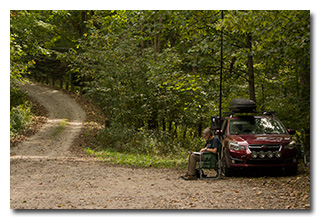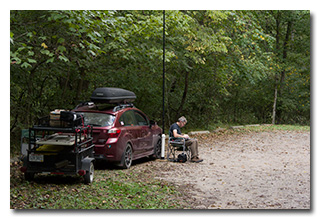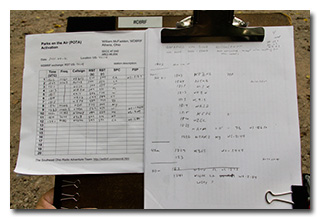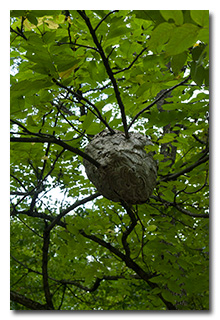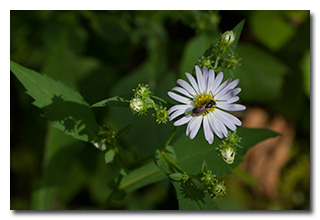
by William Eric McFadden
From the nature preserve's website:
-
This 491-acre preserve encompasses a variety of habitats typical of Appalachian Ohio. The area is diverse in vegetation and ranges from various successional stages to mature forests in the deep ravines and on the steep hillsides. The area is dissected by Jordan Run, a tributary of the Hocking River, and has steep topography, varying from 680 to 900 feet in elevation. Large beech and oak trees are found in the cool moist ravines while the drier uplands are dominated by oak hickory forests, typical of the region.
Due to the diversity of the landscape, a large variety of ferns and wildflowers abound. Some of the more interesting plants include weak aster, green adder's-mouth orchid and Virginia meadow-beauty. Mistletoe, a parasitic plant on trees, has also been reported from this preserve. The most notable landscape feature is a large pond created by beaver, complete with many trees bearing the marks of these industrious animals and a stick-built den. The pond, which stretches for several acres, draws a variety of migratory waterfowl.
The preserve was a gift of Henry I. Stein, who gave the area to the Division of Natural Areas and Preserves in 1974 as a memorial to his sister, Marie J. Desonier.
Pictures
- Eric operating: 1 | 2; photos by Miles McFadden
- A Hornets' Nest; photo by Miles McFadden
- Flow and Polinator; photo by Miles McFadden
- Eric's log
Description
On Saturday, September 21, 2024, two members of the Southeast Ohio Radio Adventure Team performed a successful activation of Desonier State Nature Preserve in Ohio as part of the Parks on the Air (POTA; link) program.
Following a visit to the Buffalo Ham Radio Swap Meet and Car Show (info), Eric McFadden, WD8RIF, and Miles McFadden, KD8KNC, visited Desonier State Nature Preserve on a hot and brutally sunny afternoon. They were accompanied by Vickie McFadden, Theo-dog, and Ginny-dog.
Arriving at the small parking lot at about 1745 UTC, Miles parked his car and small trailer as considerately as he could and, following a field-repair to a counterpoise wire, he and Eric deployed a 28½' wire vertical on a Jackite 31' telescoping fiberglass mast and drive-on mount, laying three 17' counterpoise wires directly on the ground. Eric set up his Elecraft KX2 on his camp-chair's flip-up table and was on the air at 1803 UTC.
As he had expected, Eric found he had good cell-signal at this location, and he would be able to spot himself to POTA Spots (link) and to use POTA Spots to identify possible park-to-park (P2P) QSO opportunities.
Eric had planned to participate in the New England QRP Club's annual QRP Afield field operating event (info), and to try to make P2P QSOs in the Wisconsin Parks on the Air event (info), but the brutal sun experienced during the hamfest led Eric to concentrate, instead, on just validating his POTA activation as expeditiously as he could.
Eric began his operation on 20m. As soon as he set his KX2 to the band, he found K8BHS at F.D. Roosevelt State Park (US-2173) in Georgia calling "CQ POTA" and Eric completed a P2P QSO with him at 1803 UTC.
Finding himself a clear 20m frequency to run, Eric began calling "CQ POTA" and was auto-spotted on POTA Spots. His first QSO in this run came at 1809 UTC with stalwart hunter AA5UZ in Louisiana. QSOs came steadily, with Eric's seventh QSO in this run coming at 1820 UTC with N2EC in New York. This run included QSOs with stations located in Louisiana, Massachusetts, Florida, Wisconsin, Connecticut, Texas, and New York.
Pausing to check POTA Spots for P2P QSO opportunities, at 1823 UTC Eric made a P2P QSO on 20m with NA9M at Nevin Springs State Fish and Wildlife Area (US-10650) in Wisconsin. (NA9M might well have been participating in Wisconsin Parks on the Air.) At 1826 UTC, Eric made a P2P QSO on 20m with N2AKJ at Tallman Mountain State Park (US-2149) in New York. At 1829 UTC, Eric made a P2P QSO on 40m with K8ES at Deer Creek State Park (US-1945) in Ohio.
Finding himself a clear frequency on 40m to run, Eric began calling "CQ POTA" and was auto-spotted on POTA Spots. Eric called for several minutes with no replies before noticing that he and K3ES were the only stations spotted on 40m on POTA Spots.
Pausing again hunt for P2P QSOs using POTA Spots, at 1841 UTC Eric made a P2P QSO on 20m with K4EAK at Little Ocmulgee State Park (US-2189) in Georgia.
In all, Eric made twelve QSOs, including five P2P QSOs, in about forty minutes. All of Eric's QSOs were CW and were made with five watts output.
Miles did not operate but helped with station set-up and tear-down and did most of the activation photography.
(return)
